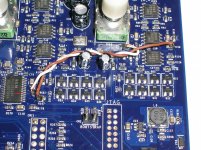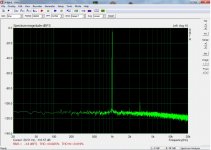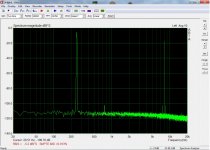Hi everyone,
I've been using EMU 0404 USB for audio measurements for a while but I find them unreliable having now got through 3 units in about 6 years. Issues with outputs and inputs both. Possibly because the idiotz didn't include DC coupling capacitors on inputs nor outputs and I inevitably stick some DC bias up its ***.
I can't however find a reasonably priced alternative. Any help?
I need something with good ADC and DAC chips that are not crippled by the analog section (like Creative X-FI). I only need 2 IN / 2 OUT.
Most seem to use codec chips that don't really have great analog performance or are crippled by a poor analog buffer section and possibly cmos switching stages.
Anything short of RME going to cut it?
I've been using EMU 0404 USB for audio measurements for a while but I find them unreliable having now got through 3 units in about 6 years. Issues with outputs and inputs both. Possibly because the idiotz didn't include DC coupling capacitors on inputs nor outputs and I inevitably stick some DC bias up its ***.
I can't however find a reasonably priced alternative. Any help?
I need something with good ADC and DAC chips that are not crippled by the analog section (like Creative X-FI). I only need 2 IN / 2 OUT.
Most seem to use codec chips that don't really have great analog performance or are crippled by a poor analog buffer section and possibly cmos switching stages.
Anything short of RME going to cut it?
Hi everyone,
I've been using EMU 0404 USB for audio measurements for a while but I find them unreliable having now got through 3 units in about 6 years. Issues with outputs and inputs both. Possibly because the idiotz didn't include DC coupling capacitors on inputs nor outputs and I inevitably stick some DC bias up its ***.
I found this a feature, they do the high pass digitally and with a simple mod it can be disabled so you have a DC coupled measurement instrument.
QA has open-source ASIO drivers now GitHub - dechamps/ASIO401: An unofficial ASIO driver for the QuantAsylum QA401 audio analyzer.
How complicated can adding the coupling caps be?
How complicated can adding the coupling caps be?
I found this a feature, they do the high pass digitally and with a simple mod it can be disabled so you have a DC coupled measurement instrument.
Hi Scott
Any info on that simple mod?
George
It was years ago, I no longer have it. You need to open it up and download the datasheet for the AK**** A/D chip. There is a logic pin that enables the high-pass filter. IIRC It is tied low, so you just pull the pin up off the pad and solder a jumper to high. There was a DC offset that was different on each channel I just lived with that.Hi Scott
Any info on that simple mod?
George
I did this for a work project, heart rate monitor. We were studying the effects of LED noise on those little clip on blood oxygen sensors and I needed an A/D that went down well below 1Hz. I didn't want to setup a National Instruments box and learn Labview.
EDIT - It might have been the 0204 that I modded.
Last edited:
I didn't want to setup a National Instruments box and learn Labview.
Lazy you
You are right.
The 0404 has the AK5385A A/D.
AK5385AVF pdf, AK5385AVF description, AK5385AVF datasheets, AK5385AVF view ::: ALLDATASHEET :::
The pin to be targeted is the pin19 (HPFE). Most probably filter state is SW controlled (H: enabled, L: disabled).
When I’ll reopen the soundcard, I will measure the DC on that pin to see what is going on.
Thank you Scott for informing us about this useful modification.
George
Attachments
I've been playing with Behringer UCA202 paired with Pete Millett's PC interface for a low cost measuring setup. At some point one input of the soundcard died for no obvious reason so in an attempt to save it I did something that I already was thinking about; I completely bypassed input and output opamp stages and connected the audio codec chip http://coolaudio.com/docs/COOLAUDIO_V2902_DATASHEET.pdf straight on Millett's circuit (through 4,7μf caps). It now does very nice FFT for such a humble chip - see pics. The problem appears when I try to take impedance measurements with ARTA limp. Everything goes fine up to 11-12kHz and then disaster. I guess is the built-in antialiasing filter but I can't tell for sure. Unfortunately, this chip doesn't seem to provide external control on this or do I miss it? Anyway, I'm thinking to acquire Steinberg ur22. Any experience or opinions on this soundcard would very interesting.
Attachments
Lazy you
You are right.
The 0404 has the AK5385A A/D.
AK5385AVF pdf, AK5385AVF description, AK5385AVF datasheets, AK5385AVF view ::: ALLDATASHEET :::
The pin to be targeted is the pin19 (HPFE). Most probably filter state is SW controlled (H: enabled, L: disabled).
When I’ll reopen the soundcard, I will measure the DC on that pin to see what is going on.
Thank you Scott for informing us about this useful modification.
George
Note these chips do need a mid-rail DC offset on the input to function correctly, so there will always be a significant offset if you disable that pin.
I've been playing with Behringer UCA202 paired with Pete Millett's PC interface for a low cost measuring setup. At some point one input of the soundcard died for no obvious reason so in an attempt to save it I did something that I already was thinking about; I completely bypassed input and output opamp stages and connected the audio codec chip http://coolaudio.com/docs/COOLAUDIO_V2902_DATASHEET.pdf straight on Millett's circuit (through 4,7μf caps). It now does very nice FFT for such a humble chip - see pics. The problem appears when I try to take impedance measurements with ARTA limp. Everything goes fine up to 11-12kHz and then disaster. I guess is the built-in antialiasing filter but I can't tell for sure. Unfortunately, this chip doesn't seem to provide external control on this or do I miss it? Anyway, I'm thinking to acquire Steinberg ur22. Any experience or opinions on this soundcard would very interesting.
The analog stage is usually the weak point of Behringer gear. I kind of wonder if they do it on purpose so they can still justify the more expensive brands owned by Music Group.
I was playing with the Behringer UMC202HD, in stock form it is not good enough for hi-fi measurements but there are some things you can do to improve it. I stalled on that project when I came to trace out the CMOS switching that goes on with the input. My guess is that the CMOS chip is adding a fair bit of crap to the signal. You could DI to the ADC chip but then you loose the good functionality.
Note these chips do need a mid-rail DC offset on the input to function correctly, so there will always be a significant offset if you disable that pin.
The offset at the output was low and behaved as expected for DC coupling at the input. It is true you would have to bring the mid-rail reference out to use as a reference for the input circuitry, I only wanted deep sub Hz input time constant.
The analog stage is usually the weak point of Behringer gear. I kind of wonder if they do it on purpose so they can still justify the more expensive brands owned by Music Group.
I was playing with the Behringer UMC202HD, in stock form it is not good enough for hi-fi measurements but there are some things you can do to improve it. I stalled on that project when I came to trace out the CMOS switching that goes on with the input. My guess is that the CMOS chip is adding a fair bit of crap to the signal. You could DI to the ADC chip but then you loose the good functionality.
I keep an eye on this soundcard. Internet reviews praise its value for money. Among many features it's the very low noise floor that attracts my attention. OTOH it's not rare internet reviews to be unreliable. So, I would appreciate if you could elaborate on stock form performance.
I using $80 Asus U7 mkII with modifications:
1) Took off all muting J-fets(free)
2) CS5361 to CS5381($10)
3) front end opamps opa1612 and parallel instead of originally serial stages($5)
4) arranged +/-7VDC rails for opa1612(free)
Result: SNR -119.5dbA THD@0dbfs .0003%, THD@-20dbfs cannot detect but <.0001% the same as AP2702 generator. Due to high common mode noise of the PC USB, I use that ADC with 600:600 permalloy trafo and 1kHz -40db notch if needed. ADC+trafo+notch reads <.00006%@1VRMS@1kHz from AP2702 generator with THD .00003%. At 7VRMS .0002%, 4VRMS THD .0001%, at 500mVRMS .00007%, 200mVRMS .0002%, 100mVRMS .0004%.
1) Took off all muting J-fets(free)
2) CS5361 to CS5381($10)
3) front end opamps opa1612 and parallel instead of originally serial stages($5)
4) arranged +/-7VDC rails for opa1612(free)
Result: SNR -119.5dbA THD@0dbfs .0003%, THD@-20dbfs cannot detect but <.0001% the same as AP2702 generator. Due to high common mode noise of the PC USB, I use that ADC with 600:600 permalloy trafo and 1kHz -40db notch if needed. ADC+trafo+notch reads <.00006%@1VRMS@1kHz from AP2702 generator with THD .00003%. At 7VRMS .0002%, 4VRMS THD .0001%, at 500mVRMS .00007%, 200mVRMS .0002%, 100mVRMS .0004%.
- Status
- This old topic is closed. If you want to reopen this topic, contact a moderator using the "Report Post" button.
- Home
- Source & Line
- PC Based
- USB Interface for Measurements?


